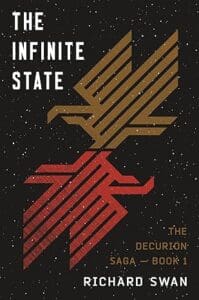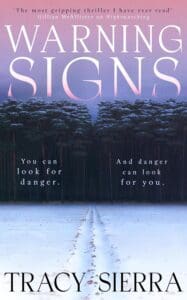
Synopsis:
Single mom Harry Adams has always loved horror movies, so when she’s offered a job cleaning for revered horror director Javier Castillo, she leaps at the chance. His forbidding Chicago mansion, Bright Horses, is filled from top to bottom with terrifying props and costumes, as well as glittering awards from his decades-long career making films that thrilled audiences and dominated the box office—until family tragedy and scandal forced him to vanish from the industry.
Javier values discretion, so Harry tries to clean the house immaculately and keep her head down—she needs the money from this job to support her son. But then she starts hearing noises from behind a locked door. Noises that sound remarkably like a human voice calling for help, though Javier lives alone and never has visitors. Harry knows that not asking questions is a vital part of keeping her job, but she soon finds that the house—and her enigmatic boss—have secrets she can’t ignore…
Review:
“The House That Horror Built,” is clearly a book written by a horror fanatic for horror fanatics. At first, I was rooting for the characters, somewhat intrigued by the mystery, and overall having a good time, but at about the halfway mark its charm began to fizzle. Alas, by the time I reached its predictable denouement, even the horror movie easter eggs couldn’t redeem me. For readers looking for something light-hearted and easy to read with a mildly spooky twist, this may suit, but I’m saddened to say that this one missed the mark for me. Regardless, I would like to thank Titan for sending me an ARC copy in return for my unfiltered thoughts (and for this stunning cover), “The House That Horror Built,” comes out May 20th 2024.
We follow single mother Harry Adams and her 14 year old son Gabe, who like all of us, are recovering from the covid-19 pandemic. Having lost her waitressing job, she’s lucky to have snagged a gig as a part-time cleaner, a job which just about pays the rent on her shabby apartment. Her employer? Esteemed (but now reclusive) director Javier Castillo. At first, things were going swimmingly. Mr. Castillo is distant, however he is after all her boss, and there’s a whole lot of dusting horror movie memorabilia, but as a huge fan of Castillo and the wider genre, it’s actually a pretty neat arrangement. As for the house, which could fit Harry’s whole apartment in its basement, well, there’s the whines and creaks and groans you’d expect from a place that old. The relentless tapping and distant cries for help however? Slightly more concerning.
The characters are really quite three-dimensional, and used to explore some heavy themes such as homelessness, growing up and the glittery pitfalls of fame. We read mainly from Harry’s perspective, although tidbits of information are thrown to us through flashbacks from Harry and Javier’s lives. So many layers are added, it ends up reading like a delicious horror lasagne. Harry’s unconditional love for Gabe in contrast with Javier’s own parenting makes for a very nice character study on the multifaceted nature of parenthood. Speaking of Gabe, he’s a mini-gothic legend in the making, and as he reminded me of my own brooding youth, he kinda stole my heart. As well as being the source of comic relief, we see glimpses of maturity and sombreness within him, serving as a reminder that kids do not stay kids forever… and they’re smarter than you think.
Furthermore, Henry comments heavily on class, through contrasting the characters of Harry and Javier. The haunted house is a horror staple, but it seems here like the illustrious “Bright Horses,” (the house that Javier resides in) is used as more of a way to highlight the economic deficit between them, and perhaps even reflect the mystery and secrecy that often surrounds the super-rich and famous.
Now… onto the nitty gritty, My first issue leans more on personal taste than an objective flaw, although it’s worth noting that this is marketed as an adult horror novel. Minus the stress that the protagonist endures (adulting huh) I think it’s reasonable to argue that this is a piece of young adult fiction. If that’s what you’re looking for, then happy days, but it is not my scene. I don’t think however, that YA can explain away my biggest qualm. This is a book featuring potentially sentient horror movie props, there is banging on the walls and mysterious cries for help… but this novel is inexplicably devoid of tension. I think this is a book that’s practically begging for just a little suspense. I have to face the music, Christina Henry’s writing just doesn’t strike a chord with me. Although I found the plot more engaging than my previous experience with “Near The Bone,” the somewhat basic writing style remains consistent, sadly, not something that aligns with my preferences.
More frustratingly, there were numerous signals practically screaming “red herring,” throughout, but no such twist awaits. Unless I’m a modern day Poirot, then the ending is about as predictable as yesterday’s weather forecast; as foreseeable as a knock-knock joke. You’d think considering that Henry arguably relies on her characters as opposed to her prose or plot (which is absolutely fine mind you) the reader would bid the protagonists farewell somewhat aware of their fate. Not here! I was left grappling with some pretty elementary questions regarding what the future holds for Harry and Gabe. Between the unimpressive plot twist and bizarrely abrupt ending, the novel fizzles out, when really, it needed to end with a bang.
In conclusion, Christina Henry’s latest is a book that promises a spine-tingling haunted house story, and delivers… something else entirely. Despite its entertaining premise and lovable characters, unfortunately “The House That Horror Built,” serves as a reminder that not every scare is a winner.









Leave a Reply